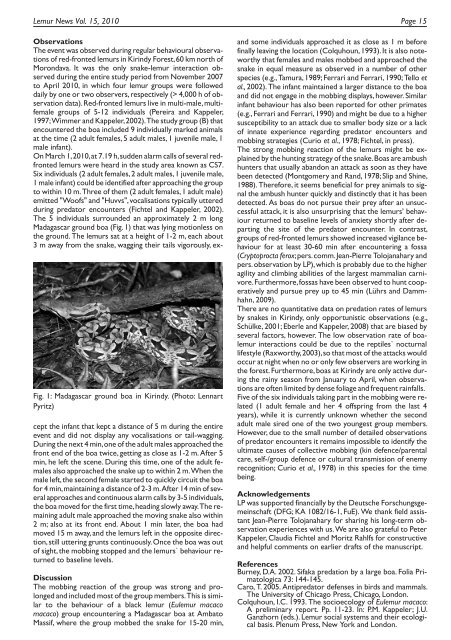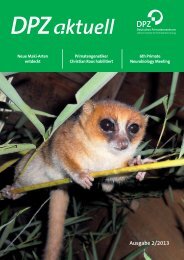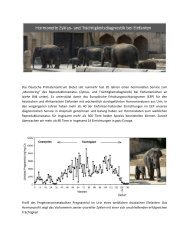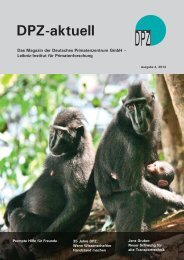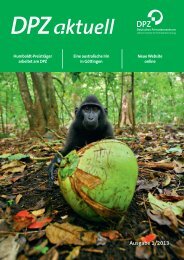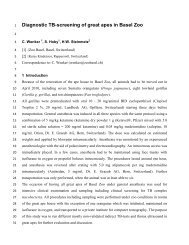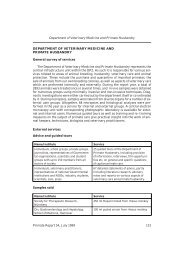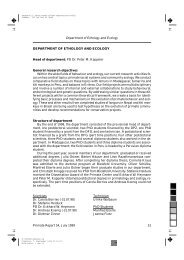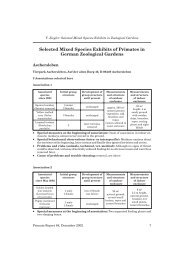Vol. 15 - Deutsches Primatenzentrum
Vol. 15 - Deutsches Primatenzentrum
Vol. 15 - Deutsches Primatenzentrum
Create successful ePaper yourself
Turn your PDF publications into a flip-book with our unique Google optimized e-Paper software.
Lemur News <strong>Vol</strong>. <strong>15</strong>, 2010 Page <strong>15</strong><br />
Observations<br />
The event was observed during regular behavioural observations<br />
of red-fronted lemurs in Kirindy Forest,60 km north of<br />
Morondava. It was the only snake-lemur interaction observed<br />
during the entire study period from November 2007<br />
to April 2010, in which four lemur groups were followed<br />
daily by one or two observers,respectively (> 4,000 h of observation<br />
data).Red-fronted lemurs live in multi-male,multifemale<br />
groups of 5-12 individuals (Pereira and Kappeler,<br />
1997;Wimmer and Kappeler,2002).The study group (B) that<br />
encountered the boa included 9 individually marked animals<br />
at the time (2 adult females, 5 adult males, 1 juvenile male, 1<br />
male infant).<br />
On March 1,2010,at 7.19 h,sudden alarm calls of several redfronted<br />
lemurs were heard in the study area known as CS7.<br />
Six individuals (2 adult females,2 adult males,1 juvenile male,<br />
1 male infant) could be identified after approaching the group<br />
to within 10 m.Three of them (2 adult females,1 adult male)<br />
emitted "Woofs" and "Huvvs",vocalisations typically uttered<br />
during predator encounters (Fichtel and Kappeler, 2002).<br />
The 5 individuals surrounded an approximately 2 m long<br />
Madagascar ground boa (Fig. 1) that was lying motionless on<br />
the ground. The lemurs sat at a height of 1-2 m, each about<br />
3 m away from the snake, wagging their tails vigorously, ex-<br />
Fig. 1: Madagascar ground boa in Kirindy. (Photo: Lennart<br />
Pyritz)<br />
cept the infant that kept a distance of 5 m during the entire<br />
event and did not display any vocalisations or tail-wagging.<br />
During the next 4 min,one of the adult males approached the<br />
front end of the boa twice, getting as close as 1-2 m. After 5<br />
min, he left the scene. During this time, one of the adult females<br />
also approached the snake up to within 2 m.When the<br />
male left,the second female started to quickly circuit the boa<br />
for 4 min,maintaining a distance of 2-3 m.After 14 min of several<br />
approaches and continuous alarm calls by 3-5 individuals,<br />
the boa moved for the first time,heading slowly away.The remaining<br />
adult male approached the moving snake also within<br />
2 m; also at its front end. About 1 min later, the boa had<br />
moved <strong>15</strong> m away, and the lemurs left in the opposite direction,still<br />
uttering grunts continuously.Once the boa was out<br />
of sight, the mobbing stopped and the lemurs` behaviour returned<br />
to baseline levels.<br />
Discussion<br />
The mobbing reaction of the group was strong and prolonged<br />
and included most of the group members.This is similar<br />
to the behaviour of a black lemur (Eulemur macaco<br />
macaco) group encountering a Madagascar boa at Ambato<br />
Massif, where the group mobbed the snake for <strong>15</strong>-20 min,<br />
and some individuals approached it as close as 1 m before<br />
finally leaving the location (Colquhoun, 1993). It is also noteworthy<br />
that females and males mobbed and approached the<br />
snake in equal measure as observed in a number of other<br />
species (e.g., Tamura, 1989; Ferrari and Ferrari, 1990; Tello et<br />
al., 2002). The infant maintained a larger distance to the boa<br />
and did not engage in the mobbing displays, however. Similar<br />
infant behaviour has also been reported for other primates<br />
(e.g., Ferrari and Ferrari, 1990) and might be due to a higher<br />
susceptibility to an attack due to smaller body size or a lack<br />
of innate experience regarding predator encounters and<br />
mobbing strategies (Curio et al., 1978; Fichtel, in press).<br />
The strong mobbing reaction of the lemurs might be explained<br />
by the hunting strategy of the snake.Boas are ambush<br />
hunters that usually abandon an attack as soon as they have<br />
been detected (Montgomery and Rand, 1978; Slip and Shine,<br />
1988). Therefore, it seems beneficial for prey animals to signal<br />
the ambush hunter quickly and distinctly that it has been<br />
detected. As boas do not pursue their prey after an unsuccessful<br />
attack, it is also unsurprising that the lemurs’ behaviour<br />
returned to baseline levels of anxiety shortly after departing<br />
the site of the predator encounter. In contrast,<br />
groups of red-fronted lemurs showed increased vigilance behaviour<br />
for at least 30-60 min after encountering a fossa<br />
(Cryptoprocta ferox;pers.comm.Jean-Pierre Tolojanahary and<br />
pers.observation by LP),which is probably due to the higher<br />
agility and climbing abilities of the largest mammalian carnivore.Furthermore,fossas<br />
have been observed to hunt cooperatively<br />
and pursue prey up to 45 min (Lührs and Dammhahn,<br />
2009).<br />
There are no quantitative data on predation rates of lemurs<br />
by snakes in Kirindy, only opportunistic observations (e.g.,<br />
Schülke, 2001; Eberle and Kappeler, 2008) that are biased by<br />
several factors, however. The low observation rate of boalemur<br />
interactions could be due to the reptiles` nocturnal<br />
lifestyle (Raxworthy,2003),so that most of the attacks would<br />
occur at night when no or only few observers are working in<br />
the forest. Furthermore, boas at Kirindy are only active during<br />
the rainy season from January to April, when observations<br />
are often limited by dense foliage and frequent rainfalls.<br />
Five of the six individuals taking part in the mobbing were related<br />
(1 adult female and her 4 offspring from the last 4<br />
years), while it is currently unknown whether the second<br />
adult male sired one of the two youngest group members.<br />
However, due to the small number of detailed observations<br />
of predator encounters it remains impossible to identify the<br />
ultimate causes of collective mobbing (kin defence/parental<br />
care, self-/group defence or cultural transmission of enemy<br />
recognition; Curio et al., 1978) in this species for the time<br />
being.<br />
Acknowledgements<br />
LP was supported financially by the Deutsche Forschungsgemeinschaft<br />
(DFG; KA 1082/16-1, FuE). We thank field assistant<br />
Jean-Pierre Tolojanahary for sharing his long-term observation<br />
experiences with us. We are also grateful to Peter<br />
Kappeler, Claudia Fichtel and Moritz Rahlfs for constructive<br />
and helpful comments on earlier drafts of the manuscript.<br />
References<br />
Burney, D.A. 2002. Sifaka predation by a large boa. Folia Primatologica<br />
73: 144-145.<br />
Caro, T. 2005. Antipredator defenses in birds and mammals.<br />
The University of Chicago Press, Chicago, London.<br />
Colquhoun, I.C. 1993. The socioecology of Eulemur macaco:<br />
A preliminary report. Pp. 11-23. In: P.M. Kappeler; J.U.<br />
Ganzhorn (eds.). Lemur social systems and their ecological<br />
basis. Plenum Press, New York and London.


